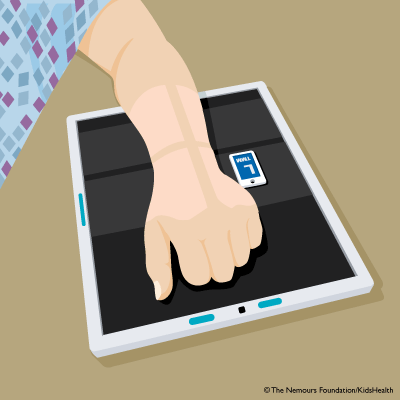Wrist X-Ray Exam
Overview
What’s a Wrist X-Ray and What Does It Show?
A wrist X-ray is a safe and painless test that uses a small amount of radiation to make an image of the bones inside the wrist. It also shows the ends of the forearm bones.
An X-ray of the wrist joint (where the hand and forearm meet) can help with:
- Injuries and healing. The test can help find the cause of wrist pain, swelling, or tenderness. A wrist X-ray shows broken bones, dislocated joints (one or more bones at a joint that are out of place), and deformities (changes in shape or size). After a bone is set, an X-ray of a broken wrist can show if the bones are lined up and healing properly.
- Planning and diagnosing. Doctors use wrist X-rays to plan surgery — when needed — and check how well it worked after. The tests can sometimes also help find cysts (sacs filled with air, liquid, or pus), infections, tumors, and other bone diseases.
- Growth checks. Sometimes, a wrist X-ray is part of a bone age study to help look for growth problems.
Top Things to Know
- A wrist X-ray is a quick and pain-free test that makes pictures of the inside of the wrist.
- It can show if there’s a break, swelling, or other problem in the wrist joint.
- The X-ray uses a very small amount of radiation, which is safe for kids.
- Your child will need to stay still for a few seconds so the images come out clear.
What to Expect
How Does a Wrist X-Ray Work?
In a wrist X-ray, an X-ray machine sends a beam of radiation through the wrist, and an image is recorded on special X-ray film or a computer screen.
The X-ray image is black and white. Dense body parts, like bones, block the passage of the X-ray beam through the body. These look white on the X-ray image. Softer body tissues, like the skin and muscles, let the X-ray beams pass through them. They look darker on the image.
A wrist X-ray shows the ends of the forearm bones (radius and ulna), the eight small wrist bones (carpal bones), and the soft tissues around the bones.
What Happens Before a Wrist X-Ray?
To get ready for a wrist X-ray, kids will need to take off any jewelry on their wrists or hands so it won’t affect the image. The test often happens in a special room that has a table and an X-ray machine. A parent can usually stay in the room. Tell the X-ray technician if you’re pregnant because developing babies are more sensitive to radiation.
If your child is in the hospital, sometimes a portable X-ray machine can be brought to the bedside.
You can help your child prepare by explaining the test in simple terms. Say that it’s important to hold still to get the best images.
What Happens During a Wrist X-Ray?
Wrist X-rays take just a few minutes. They’re done while your child sits and places the hand and wrist on the table. After getting your child into the right position, an X-ray technician will go into the next room to take the images. Kids should stay still for 2–3 seconds while each X-ray is taken so the pictures are clear. If an image is blurred, the technician might need to take another one. Older kids may be asked to hold their breath for a few seconds to help keep them from moving.

The X-ray technician will take pictures of the wrist:
- from the back with the palm facing down
- from the side
- at an angle
If your child has an injury and can't stay in the right position, the technician can help find a position that feels better. Sometimes doctors also want an X-ray of the other “normal” wrist to compare.
What Happens After a Wrist X-Ray?
A radiologist (a doctor specially trained in reading and understanding X-rays) will look at the images and help figure out what the results mean. This person will send a report to your doctor, who will explain what the X-rays show.
X-rays can be read quickly, especially in an emergency. The doctor seeing your child can sometimes look at the X-ray before getting the official read from the radiologist. But in most cases, results can't be given directly to the patient or family at the time of the test.
What Else Should I Know?
Wrist X-rays are safe. There can be some risk to the body with radiation, but the amount in wrist X-rays is so small that it’s not dangerous. X-ray technicians use the least radiation needed to get the best images.
Based on the results of the wrist X-ray, your child may need a follow-up appointment with the doctor or to get more X-rays or other imaging tests.
If you have questions about the wrist X-ray or what the results mean, speak with your doctor. You can also talk to the X-ray technician before the test.

© 1995- The Nemours Foundation. KidsHealth® is a registered trademark of The Nemours Foundation. All rights reserved.
Images sourced by The Nemours Foundation and Getty Images.













